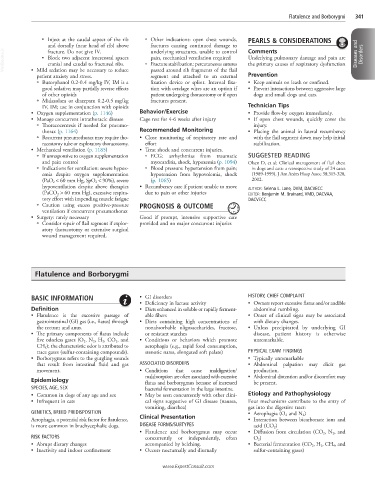Page 730 - Cote clinical veterinary advisor dogs and cats 4th
P. 730
Flatulence and Borborygmi 341
Inject at the caudal aspect of the rib ○ Other indications: open chest wounds,
■ PEARLS & CONSIDERATIONS
and dorsally (near head of rib) above fractures causing continued damage to Comments
VetBooks.ir ■ Block two adjacent intercostal spaces ○ Fracture stabilization: percutaneous sutures Underlying pulmonary damage and pain are Diseases and Disorders
underlying structures, unable to control
fracture. Do not give IV.
pain, mechanical ventilation required
the primary causes of respiratory dysfunction
cranial and caudal to fractured ribs.
• Mild sedation may be necessary to reduce
patient anxiety and stress. passed around rib fragments of the flail Prevention
segment and attached to an external
○ Butorphanol 0.2-0.4 mg/kg IV, IM is a fixation device or splint. Internal fixa- • Keep animals on leash or confined.
good sedative; may partially reverse effects tion with cerclage wires are an option if • Prevent interactions between aggressive large
of other opioids patient undergoing thoracotomy or if open dogs and small dogs and cats.
○ Midazolam or diazepam 0.2-0.5 mg/kg fractures present.
IV, IM; use in conjunction with opioids Technician Tips
• Oxygen supplementation (p. 1146) Behavior/Exercise • Provide flow-by oxygen immediately.
• Manage concurrent intrathoracic disease Cage rest for 4-6 weeks after injury • If open chest wounds, quickly cover the
○ Thoracocentesis if needed for pneumo- injury.
thorax (p. 1164) Recommended Monitoring • Placing the animal in lateral recumbency
○ Recurrent pneumothorax may require tho- • Close monitoring of respiratory rate and with the flail segment down may help initial
racostomy tube or exploratory thoracotomy. effort stabilization.
• Mechanical ventilation (p. 1185) • Treat shock and concurrent injuries.
○ If unresponsive to oxygen supplementation ○ ECG: arrhythmias from traumatic SUGGESTED READING
and pain control myocarditis, shock, hypoxemia (p. 1094) Olsen D, et al: Clinical management of flail chest
○ Indications for ventilation: severe hypox- ○ Blood pressure: hypertension from pain; in dogs and cats: a retrospective study of 24 cases
emia despite oxygen supplementation hypotension from hypovolemia, shock (1989-1999). J Am Anim Hosp Assoc 38:315-320,
(PaO 2 < 60 mm Hg, SpO 2 < 90%), severe (p. 1065) 2002.
hypoventilation despite above therapies • Recumbency care if patient unable to move AUTHOR: Selena L. Lane, DVM, DACVECC
(PaCO 2 > 60 mm Hg), excessive respira- due to pain or other injuries EDITOR: Benjamin M. Brainard, VMD, DACVAA,
tory effort with impending muscle fatigue DACVECC
○ Caution using excess positive-pressure PROGNOSIS & OUTCOME
ventilation if concurrent pneumothorax
• Surgery: rarely necessary Good if prompt, intensive supportive care
○ Consider repair of flail segment if explor- provided and no major concurrent injuries
atory thoracotomy or extensive surgical
wound management required.
Flatulence and Borborygmi
BASIC INFORMATION • GI disorders HISTORY, CHIEF COMPLAINT
• Deficiency in lactase activity • Owners report excessive flatus and/or audible
Definition • Diets enhanced in soluble or rapidly ferment- abdominal rumbling.
• Flatulence is the excessive passage of able fibers • Onset of clinical signs may be associated
gastrointestinal (GI) gas (i.e., flatus) through • Diets containing high concentrations of with dietary changes.
the rectum and anus. nonabsorbable oligosaccharides, fructose, • Unless precipitated by underlying GI
• The primary components of flatus include or resistant starches disease, patient history is otherwise
five odorless gases (O 2, N 2, H 2, CO 2 , and • Conditions or behaviors which promote unremarkable.
CH 4 ); the characteristic odor is attributed to aerophagia (e.g., rapid food consumption,
trace gases (sulfur-containing compounds). stenotic nares, elongated soft palate) PHYSICAL EXAM FINDINGS
• Borborygmus refers to the gurgling sounds • Typically unremarkable
that result from intestinal fluid and gas ASSOCIATED DISORDERS • Abdominal palpation may elicit gas
movement. • Conditions that cause maldigestion/ production.
malabsorption are often associated with excessive • Abdominal distention and/or discomfort may
Epidemiology flatus and borborygmus because of increased be present.
SPECIES, AGE, SEX bacterial fermentation in the large intestine.
• Common in dogs of any age and sex • May be seen concurrently with other clini- Etiology and Pathophysiology
• Infrequent in cats cal signs suggestive of GI disease (nausea, Four mechanisms contribute to the entry of
vomiting, diarrhea) gas into the digestive tract:
GENETICS, BREED PREDISPOSITION • Aerophagia (O 2 and N 2)
Aerophagia, a potential risk factor for flatulence, Clinical Presentation • Interaction between bicarbonate ions and
is more common in brachycephalic dogs. DISEASE FORMS/SUBTYPES acid (CO 2)
• Flatulence and borborygmus may occur • Diffusion from circulation (CO 2, N 2, and
RISK FACTORS concurrently or independently, often O 2)
• Abrupt dietary changes accompanied by belching. • Bacterial fermentation (CO 2 , H 2 , CH 4 , and
• Inactivity and indoor confinement • Occurs nocturnally and diurnally sulfur-containing gases)
www.ExpertConsult.com

